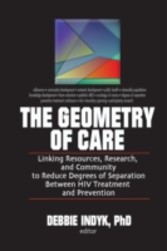Suchen und Finden

Geometry of Care - Linking Resources, Research, and Community to Reduce Degrees of Separation Between HIV Treatment and
Mehr zum Inhalt

Geometry of Care - Linking Resources, Research, and Community to Reduce Degrees of Separation Between HIV Treatment and
Connect multiple resources to form effective strategies to deal with AIDSAn effective strategy to deal with the AIDS epidemic is to have a wide range of scientists, clinicians, front-line workers, and clients distribute theory, care, and resource knowledge geometrically through all levels. The Geometry of Care: Linking Resources, Research, and Community to Reduce Degrees of Separation Between HIV Treatment and Prevention shows how to link bottom-up and top-down approaches to advance care, services, resources, training, theory, and policy analysis. Leading authorities draw upon behavioral and organizational theory to discuss the development of the frameworks necessary to effectively disseminate knowledge to benefit those needing care and to protect the community from further risk.The Geometry of Care builds a powerful case for the development of sustained links among academic resources and the community. Practical strategies are provided to set up a dynamic response framework to integrate the latest advances in treatment and prevention. The first section focuses on System and Program Level Geometry, the second on Patient and Provider Level Geometry. This is the book that shows how to meet the challenge to effectively understand, diagnose, treat, and prevent AIDS simultaneously on multiple fronts.Topics in The Geometry of Care include: expanding strategic care to include patient, community, and medical centers the assessment, dissemination, and integration of new advances the bottom-up development of links among providers, systems, and settings increased communication through the network of generalists and specialists within hospitals examples of infrastructure building at a family health service, a medical center-based AIDS center, and a home-based ambulatory care program how sustained setting/site relationships help to foster customized interventions serving clients better by tracking them through data management integration of prevention and treatment for clients dealing with multiple co-morbidities forging links between Western and traditional medicine tailoring prevention strategies to fit the individual shifting the locus of care to the HIV-positive individual an inter-organizational approach to supporting patient-provider interaction understanding barriers to adherence HIV as a family diseaseand the geometry of care as a family issue the need for partnership between patient and primary care provider individuals with HIV and their instrumental role in prevention and transmission much, much more!The Geometry of Care is a unique, horizon-expanding book that is perfect for community workers, community activists, public health professionals, HIV clinical providers, adherence specialists, applied sociologists, and other practitioners dedicated to finding ways to provide the best in care.
Alle Preise verstehen sich inklusive der gesetzlichen MwSt.






